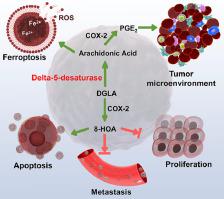Translational Oncology ( IF 5 ) Pub Date : 2021-08-23 , DOI: 10.1016/j.tranon.2021.101207 Lizhi Pang 1 , Harshit Shah 1 , Yi Xu 2 , Steven Qian 1

|
Delta-5 desaturase (D5D) is a rate-limiting enzyme that introduces double-bonds to the delta-5 position of the n-3 and n-6 polyunsaturated fatty acid chain. Since fatty acid metabolism is a vital factor in cancer development, several recent studies have revealed that D5D activity and expression could be an independent prognostic factor in cancers. However, the mechanistic basis of D5D in cancer progression is still controversial. The classical concept believes that D5D could aggravate cancer progression via mediating arachidonic acid (AA)/prostaglandin E2 production from dihomo-γ-linolenic acid (DGLA), resulting in activation of EP receptors, inflammatory pathways, and immunosuppression. On the contrary, D5D may prevent cancer progression through activating ferroptosis, which is iron-dependent cell death. Suppression of D5D by RNA interference and small-molecule inhibitor has been identified as a promising anti-cancer strategy. Inhibition of D5D could shift DGLA peroxidation pattern from generating AA to a distinct anti-cancer free radical byproduct, 8-hydroxyoctanoic acid, resulting in activation of apoptosis pathway and simultaneously suppression of cancer cell survival, proliferation, migration, and invasion. Hence, understanding the molecular mechanisms of D5D on cancer may therefore facilitate the development of novel therapeutical applications. Given that D5D may serve as a promising target in cancer, in this review, we provide an updated summary of current knowledge on the role of D5D in cancer development and potentially useful therapeutic strategies.
中文翻译:

Delta-5-去饱和酶:癌症管理的新治疗靶点
Delta-5 去饱和酶 (D5D) 是一种限速酶,可将双键引入 n-3 和 n-6 多不饱和脂肪酸链的 delta-5 位置。由于脂肪酸代谢是癌症发展的一个重要因素,最近的几项研究表明,D5D 的活性和表达可能是癌症的独立预后因素。然而,D5D 在癌症进展中的机制基础仍然存在争议。经典概念认为 D5D 可以通过介导花生四烯酸 (AA)/前列腺素 E 2来加剧癌症进展由二高-γ-亚麻酸 (DGLA) 产生,导致 EP 受体激活、炎症通路和免疫抑制。相反,D5D 可以通过激活铁死亡(铁依赖性细胞死亡)来阻止癌症进展。通过 RNA 干扰和小分子抑制剂抑制 D5D 已被确定为一种有前途的抗癌策略。抑制 D5D 可以将 DGLA 过氧化模式从生成 AA 转变为独特的抗癌自由基副产物 8-羟基辛酸,从而激活细胞凋亡途径并同时抑制癌细胞的存活、增殖、迁移和侵袭。因此,了解 D5D 对癌症的分子机制可能有助于开发新的治疗应用。



























 京公网安备 11010802027423号
京公网安备 11010802027423号